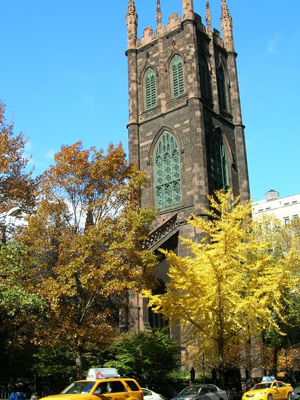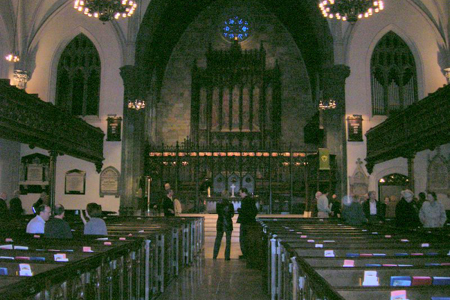| |
 |
 |
 |
| Comment on this report, or find other reports. |
 |
| Our Mystery Worshippers are volunteers who warm church pews for us around the world. If you'd like to become a Mystery Worshipper, start here. |
 |
| Find out how to reproduce this report in your church magazine or website. |
|
|
| 1665: First
Presbyterian, New York City, USA |
 |
 |
 |
Mystery Worshipper:
Clandestine Christian.
The church:
First Presbyterian,
New York City, New York.
Denomination:
Presbyterian Church
(USA).
The building:
The building dates from the mid 1840s when the congregation
(which first met in a private home in 1706) moved from Wall
Street to its current location. An architectural landmark, the
massive brownstone building and tower with battlements, pinnacles
and other Gothic Revival features was designed by Joseph C.
Wells, one of the founders of the American Institute of Architects,
and occupies the block on Fifth Avenue from 11th to 12th Streets.
It was modeled on the Church of St Saviour at Bath, England,
and the crenellated central entrance tower on the Magdalen tower
at Oxford. The grounds are nicely landscaped (although with
one particular tree they could do without – read on!) and
enclosed by an ornamented black iron fence. The interior with
high vaulted ceiling is impeccable and awe-inspiring, with dark
walnut pews, beautiful carvings and gorgeous stained glass windows.
There are no columns, no obstructions, producing the sense of
immense space. In 1893, a south transept was added, and a chancel
was added in 1919. The chancel’s stained blue glass rose
window was the gift of Robert W. de Forest, the founder of the
American Wing of the Metropolitan Museum of Art. A major restoration
project took place in the 1990s.
The church:
The history of the congregation is almost as fascinating as
its architecture. Among the first preachers was Jonathan Edwards,
whose fiery sermon "Sinners
in the Hands of an Angry God" is required reading in
many early American literature courses. In 1918 the congregation
merged with two others nearby, and called Dr Harry Emerson Fosdick,
a professor at Union Theological Seminary and an outspoken opponent
of racism and injustice, to be their associate pastor. By 1924,
as a result of the merger and in large measure due to Fosdick's
dynamic preaching, the membership swelled to 1800, the highest
it had ever been. But one of Fosdick's sermons, in which he
presented the Bible as a record of the unfolding of God’s
will, not as the literal word of God, so offended the fundamentalist
members of the congregation that Fosdick was forced to resign
in 1925. Still, the emphasis on tolerance and social justice
continues today. The church was an early supporter of the ordination
of women, and played a major role in the election of the Revd
Edler G. Hawkins as the first African-American moderator of
the national Presbyterian Church. Today, First Church's congregation
numbers around 1100, in a time when many smaller churches have
empty pews and few members. It is gay-friendly. They promote
volunteerism and run a homeless shelter in conjunction with
nearby churches. There is a midday prayer service on Wednesdays,
and Bible studies and various other classes and fellowship groups
at different times during the week.
The neighborhood:
Greenwich Village has been made famous by many musicians, artists
and writers. This area is home to jazz clubs, cafes, restaurants
and shops. Union Square, the New School and New York University
are close by. Fifth Avenue and 12th Street, where the church
is located, is at the northern edge of the Village and has a
different feel than that of the interesting little streets that
make up the Village proper. It seems more like the sedate, well-to-do
Gramercy Park and Murray Hill districts just to its north, or
even the ritzy, sophisticated Upper East Side.
The cast:
The Revd Dr Jon M. Walton, senior pastor, led the service, along
with the Revd Sarah Segal McCaslin, associate pastor, who preached.
Also assisting was the Revd Mark D. Hostetter, associate pastor.
Barbara E. Davis, minister of Christian education, gave the
children's prayer; William F. Entriken, A.Mus.D., organist and
choirmaster, was in charge of the music.
The date & time:
November 9, 2008, 11.00am.
What was the name of the service?
Service for the Lord's Day.
How full was the building?
The downstairs was almost full, but the upstairs was maybe one-quarter
full. The congregation were predominantly white but included
people from many ethnic groups, and the ages ranged from very
young children to perhaps 90 years old. I noticed all styles
of dress, from very casual to Sunday best.
Did anyone welcome you
personally?
An usher shook my hand outside the entrance door. Another usher
inside welcomed me and asked where I would like to sit, then
led me to the seat and handed me the service leaflet.
Was your pew comfortable?
Yes. The pews are covered with blue velvet cushions. No kneelers,
but there was no kneeling in the service. However, the floor
underneath the pews was thickly carpeted, and kneeling would
not have been uncomfortable.
How would you describe the pre-service
atmosphere?
I thought there was a bit too much talking. Since the service
leaflet asked the congregation to "enter quietly and offer prayers
of intercession" it was disappointing, but with so many people
it could be expected, I suppose.
What were the exact opening words of the
service?
"Good morning!"
What books did the congregation use during the
service?
The New Revised Standard Bible and the Presbyterian
Hymnal.
What musical instruments
were played?
Organ and choir. The present pipe organ was installed in 1964
by the Austin firm of Hartford, Connecticut, and incorporates
pipework from two earlier instruments. The music at First Church
is outstanding, and the choir of around 30 voices is made up
of both professionals and volunteers.

Did anything distract
you?
I was distracted by the building itself since there was so much
to look at. It would probably take several visits to become
accustomed to the grandeur. Someone behind me sang the hymns
loudly and with great enthusiasm, but terribly out of tune.
I was also rather distracted by the way the three pastors sat
facing the congregation on the great bench upon the altar. In
their black Presbyterian robes they resembled judges, and the
interior of the building a huge courtroom. Finally, I know Pastor
McCaslin is a little older than she looks and sounds, but, as
unreasonable and prejudiced as it might be, I felt as though
someone just out of college was preaching, and while it was
a very good sermon, her youthful manner was somewhat distracting
to me.
Was the worship stiff-upper-lip,
happy clappy, or what?
The service was traditional and well-paced. It was peaceful,
worshipful and pleasant. At 10.55 there was an invitation to
worship by Pastor McCaslin, followed by an organ prelude, sung
introit, and exchange of peace (which is where I think it belongs!).
There was very little liturgy – none, really, except prayers.
Some prayer were recited in unison, some only by the service
leaders. There were hymns, the scripture lessons, children's
talk, sermon, and a silent meditation. There was no communion
service. In the children's talk, Christian education minister
Barbara Davis led prayers for sick, homeless and suffering animals
as well as for people.
Exactly how long was the
sermon?
22 minutes.
On a scale of 1-10, how good was the preacher?
8 – Pastor McCaslin looks and sounds very young. Her style
was upbeat, casual and enthusiastic. Her sermon was well-written
and delivered; it related well to the scripture lessons and
included personal anecdotes.
In a nutshell, what was the sermon
about?
We recently had an election which was considered very important
to people, but choosing our God and claiming our faith is the
most important decision of our lives.
Which part of the service was like being in
heaven?
The huge choir, lovely music and glorious building. During the
final hymn, the choir came down the aisle and just stopped there
and sang, filling the aisle, filling the sanctuary with a glorious
sound and drowning out the out-of-tune singer behind me.
And which part was like being in... er... the other place?
The out-of-tune singer bothered me for the first hymn, but the
bad thing was not in the service, although it was part of the
visit. Just as I was entering the building, I noticed a terrible
odor that made me feel sick to my stomach. I thought I had stepped
in dog poop or that the front yard of the church was used as
a dog run. An usher told me that it was the large tree at the
entrance; ginkgo berries are known for their foul smell when
they fall – fortunately, that only happens for a short period
in autumn.
What happened when you hung around after the service looking lost?
Coffee hour was announced in an upstairs room. One of the pastors
shook people's hands as they were leaving the church, and another
was stationed at the upstairs room to shake their hands as they
entered for coffee. I was easily swept along with the coffee
crowd right past both of the pastors, so I didn't get to shake
either of their hands. It was the most crowded coffee hour I
had ever seen, although very social. I did indeed feel lost.
I stood there with my coffee looking around, and after less
than a minute a long-time member came up and asked if it was
my first time there. We had a nice conversation.
How would you describe
the after-service coffee?
Coffee, regular and decaf, only one kind of regular tea, and
apple juice. There were some cookies. Servers poured the coffee
and tea. Ceramic cups were used. I had to avail myself of the
facilities, and the rest rooms were in plain sight of the coffee
room and were clean and in good working order.
How would you feel about
making this church your regular (where 10 = ecstatic, 0 = terminal)?
7 – I would like to visit again; it's a very nice service,
and I could see attending regularly, but I prefer something
a little smaller, with communion every week.
Did the service make you feel glad to be a
Christian?
Yes, the sermon made me feel grateful and blessed to be a Christian; the prayers, awesome building and music all contributed to that feeling.
What one thing will you
remember about all this in seven days' time?
I will always remember that in the children's prayers animals
were prayed for as well as people. It was a rare, special moment.
Although it wasn't the "adult" prayer, a prayer is still a prayer,
and it also set a good example for the kids. I'll also remember
Pastor McCaslin. |
|
|
 |
 |
 |
| We rely on voluntary donations to stay online. If you're a regular visitor to Ship of Fools, please consider supporting us. |
 |
 |
 |
| The Mystery Pilgrim |
 |
| One of our most seasoned reporters makes the Camino pilgrimage to Santiago de Compostela in Spain. Read here. |
 |
 |
 |
| London churches |
 |
| Read reports from 70 London churches, visited by a small army of Mystery Worshippers on one single Sunday. Read here. |
| |
|
|
|
|


